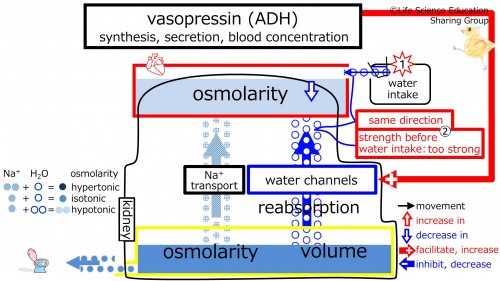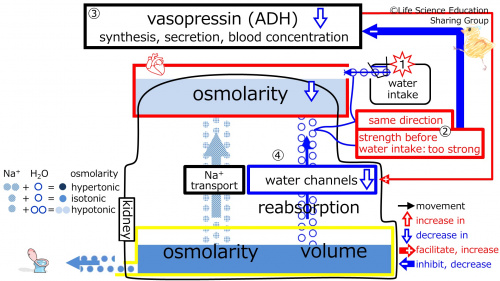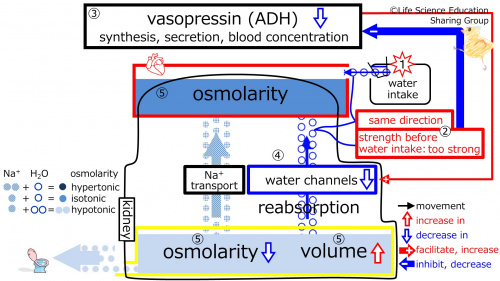「SHolroydAtWeilCornellMedQatar/Endocrinology/VasopressinADH/ControlToWaterIntake」の版間の差分
編集の要約なし |
編集の要約なし |
||
| 28行目: | 28行目: | ||
[[メディア:ADHcontrol-water-end.mp4|飲水に対してADHが低下した後の血漿、尿の2次的変化の動画]]<br> | [[メディア:ADHcontrol-water-end.mp4|飲水に対してADHが低下した後の血漿、尿の2次的変化の動画]]<br> | ||
Step 5: The ratio of Na+ to water reabsorption by the kidney increases. This means plasma osmolarity increases. The decreased plasma osmolarity from intake of water will increase returning to normal. | Step 5: The ratio of Na+ to water reabsorption by the kidney increases. This means plasma osmolarity increases. The decreased plasma osmolarity from intake of water will increase returning to normal. | ||
Because a higher ratio of Na+ is reabsorbed the fluid left in the tubule now has a lower osmolarity. The decrease in the number of water channels decreases water reabsorption so there is more water. So overall the urine becomes | Because a higher ratio of Na+ is reabsorbed the fluid left in the tubule now has a lower osmolarity. The decrease in the number of water channels decreases water reabsorption so there is more water. So overall the urine becomes less concentrated and high volume. | ||
<br style="clear:both;" /> | <br style="clear:both;" /> | ||
</div> | </div> | ||
2019年5月21日 (火) 16:36時点における版
| Intake of water will decrease plasma osmolarity. This will in turn lead to a decrease in the synthesis, secretion and blood concentration of ADH. |
飲水前の動画
Prior to drinking we assume our subject is in homeostasis with normal plasma and urine osmolarities and volumes.
飲水直後、調節前の動画
Steps 1 and 2: Water was taken. Water will enter the plasma and its osmolarity will decrease. Both intake of water and the ADH/water channels/reabsorption of water by the kidney will decrease plasma osmolarity, having the same effect. Thus, in this case with low plasma osmolarity, the effect of ADH/water channels/reabsorption would be too much.
飲水に対してADHが低下した直後の動画
Steps 3 and 4: With too much effect of ADH/water channels/reabsorption, the negative feedback decreases (the synthesis, secretion, and blood concentration of) ADH. The ADH-facilitating effect on the water channels will decrease, decreasing the number of water channels. This decreases the reabsorption of water by the kidney.
飲水に対してADHが低下した後の血漿、尿の2次的変化の動画
Step 5: The ratio of Na+ to water reabsorption by the kidney increases. This means plasma osmolarity increases. The decreased plasma osmolarity from intake of water will increase returning to normal.
Because a higher ratio of Na+ is reabsorbed the fluid left in the tubule now has a lower osmolarity. The decrease in the number of water channels decreases water reabsorption so there is more water. So overall the urine becomes less concentrated and high volume.
Challenge Quiz
<GIFT> //LEVEL:2 //RAND The negative feedback reaction to an increased intake of water is a(n) {increase~=decrease} of ADH secretion. //LEVEL:3 //RAND
The negative feedback reaction to an increased intake of water is a(n) {increase~=decrease} of aquaporin channels in the kidney.
//LEVEL:2 //RAND The negative feedback reaction to an increased intake of water is a(n) {increase~=decrease} in water reabsorption by the nephron.
//LEVEL:3 //RAND
The negative feedback reaction to an increased intake of water is a(n) {~=increase~decrease} in urine volume.
//LEVEL:3 //RAND The negative feedback reaction to an increased intake of water is a(n) {increase~=decrease} of urine osmolarity.
//LEVEL:3 //RAND The negative feedback reaction to an increased intake of water is a(n) {~=increase~decrease} of plasma osmolarity.
//LEVEL:3 //RAND When you drink water the plasma osmolarity {~=decreases~increases}. This has the effect of {increasing~=decreasing} the release ADH. This in turn {increases~=decreases} the production of aquaporins by the nephron causing {increased~=decreased} water reabsorption. Urine osmolarity will {increase~=decrease} while volume will {~=increase~decrease}. This will {decreasing~=increasing} plasma osmolarity {~=returning to normal~separating from normal}.



